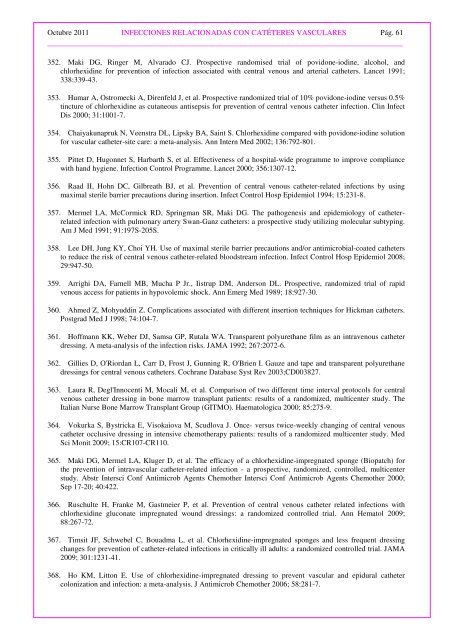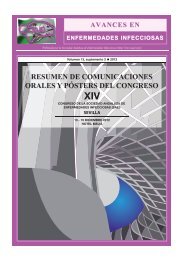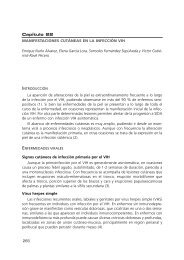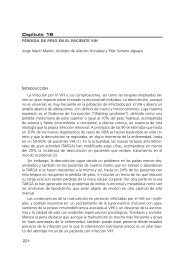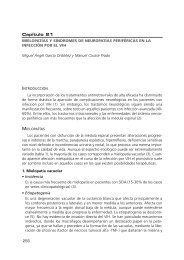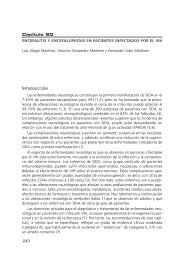Fichero a descargar de la publicación mostrada - Sociedad ...
Fichero a descargar de la publicación mostrada - Sociedad ...
Fichero a descargar de la publicación mostrada - Sociedad ...
Create successful ePaper yourself
Turn your PDF publications into a flip-book with our unique Google optimized e-Paper software.
Octubre 2011 INFECCIONES RELACIONADAS CON CATÉTERES VASCULARES Pág. 61______________________________________________________________________________352. Maki DG, Ringer M, Alvarado CJ. Prospective randomised trial of povidone-iodine, alcohol, andchlorhexidine for prevention of infection associated with central venous and arterial catheters. Lancet 1991;338:339-43.353. Humar A, Ostromecki A, Direnfeld J, et al. Prospective randomized trial of 10% povidone-iodine versus 0.5%tincture of chlorhexidine as cutaneous antisepsis for prevention of central venous catheter infection. Clin InfectDis 2000; 31:1001-7.354. Chaiyakunapruk N, Veenstra DL, Lipsky BA, Saint S. Chlorhexidine compared with povidone-iodine solutionfor vascu<strong>la</strong>r catheter-site care: a meta-analysis. Ann Intern Med 2002; 136:792-801.355. Pittet D, Hugonnet S, Harbarth S, et al. Effectiveness of a hospital-wi<strong>de</strong> programme to improve compliancewith hand hygiene. Infection Control Programme. Lancet 2000; 356:1307-12.356. Raad II, Hohn DC, Gilbreath BJ, et al. Prevention of central venous catheter-re<strong>la</strong>ted infections by usingmaximal sterile barrier precautions during insertion. Infect Control Hosp Epi<strong>de</strong>miol 1994; 15:231-8.357. Mermel LA, McCormick RD, Springman SR, Maki DG. The pathogenesis and epi<strong>de</strong>miology of catheterre<strong>la</strong>tedinfection with pulmonary artery Swan-Ganz catheters: a prospective study utilizing molecu<strong>la</strong>r subtyping.Am J Med 1991; 91:197S-205S.358. Lee DH, Jung KY, Choi YH. Use of maximal sterile barrier precautions and/or antimicrobial-coated cathetersto reduce the risk of central venous catheter-re<strong>la</strong>ted bloodstream infection. Infect Control Hosp Epi<strong>de</strong>miol 2008;29:947-50.359. Arrighi DA, Farnell MB, Mucha P Jr., Iistrup DM, An<strong>de</strong>rson DL. Prospective, randomized trial of rapidvenous access for patients in hypovolemic shock. Ann Emerg Med 1989; 18:927-30.360. Ahmed Z, Mohyuddin Z. Complications associated with different insertion techniques for Hickman catheters.Postgrad Med J 1998; 74:104-7.361. Hoffmann KK, Weber DJ, Samsa GP, Ruta<strong>la</strong> WA. Transparent polyurethane film as an intravenous catheterdressing. A meta-analysis of the infection risks. JAMA 1992; 267:2072-6.362. Gillies D, O'Riordan L, Carr D, Frost J, Gunning R, O'Brien I. Gauze and tape and transparent polyurethanedressings for central venous catheters. Cochrane Database Syst Rev 2003;CD003827.363. Laura R, Degl'Innocenti M, Mocali M, et al. Comparison of two different time interval protocols for centralvenous catheter dressing in bone marrow transp<strong>la</strong>nt patients: results of a randomized, multicenter study. TheItalian Nurse Bone Marrow Transp<strong>la</strong>nt Group (GITMO). Haematologica 2000; 85:275-9.364. Vokurka S, Bystricka E, Visokaiova M, Scudlova J. Once- versus twice-weekly changing of central venouscatheter occlusive dressing in intensive chemotherapy patients: results of a randomized multicenter study. MedSci Monit 2009; 15:CR107-CR110.365. Maki DG, Mermel LA, Kluger D, et al. The efficacy of a chlorhexidine-impregnated sponge (Biopatch) forthe prevention of intravascu<strong>la</strong>r catheter-re<strong>la</strong>ted infection - a prospective, randomized, controlled, multicenterstudy. Abstr Intersci Conf Antimicrob Agents Chemother Intersci Conf Antimicrob Agents Chemother 2000;Sep 17-20; 40:422.366. Ruschulte H, Franke M, Gastmeier P, et al. Prevention of central venous catheter re<strong>la</strong>ted infections withchlorhexidine gluconate impregnated wound dressings: a randomized controlled trial. Ann Hematol 2009;88:267-72.367. Timsit JF, Schwebel C, Bouadma L, et al. Chlorhexidine-impregnated sponges and less frequent dressingchanges for prevention of catheter-re<strong>la</strong>ted infections in critically ill adults: a randomized controlled trial. JAMA2009; 301:1231-41.368. Ho KM, Litton E. Use of chlorhexidine-impregnated dressing to prevent vascu<strong>la</strong>r and epidural cathetercolonization and infection: a meta-analysis. J Antimicrob Chemother 2006; 58:281-7.


